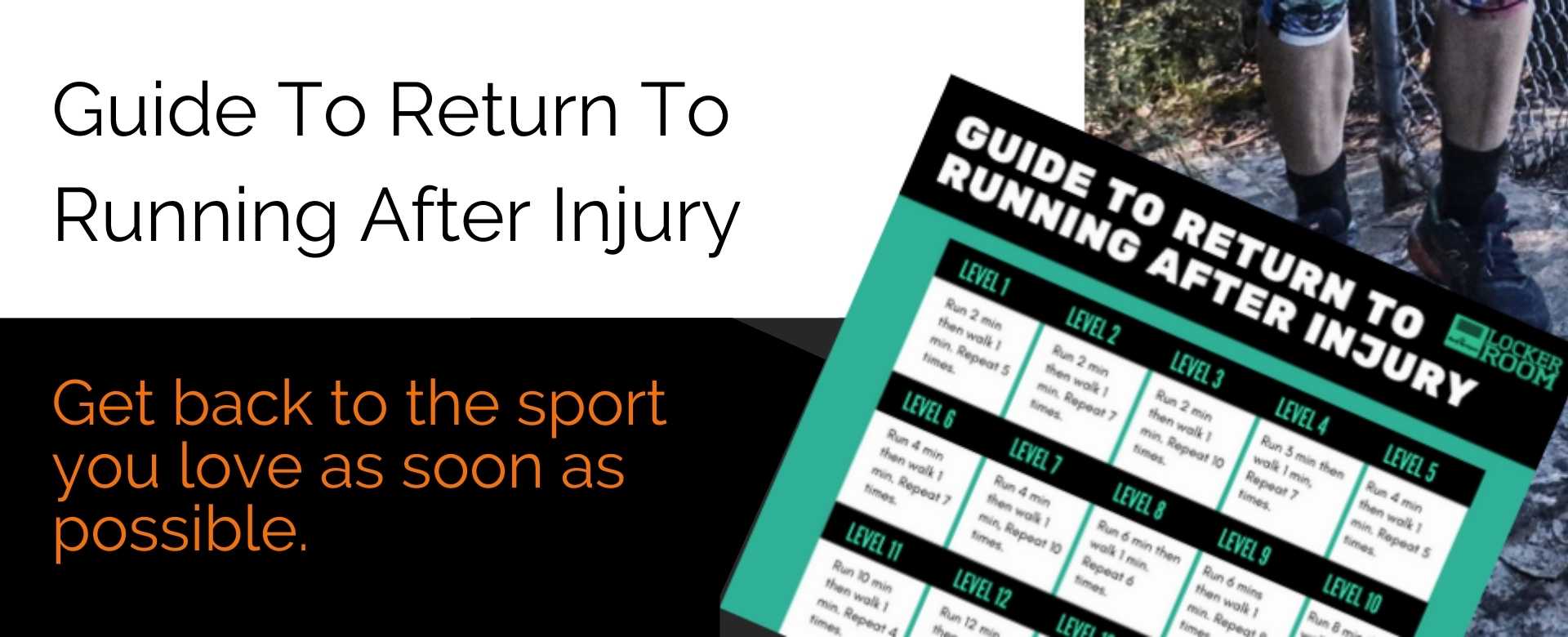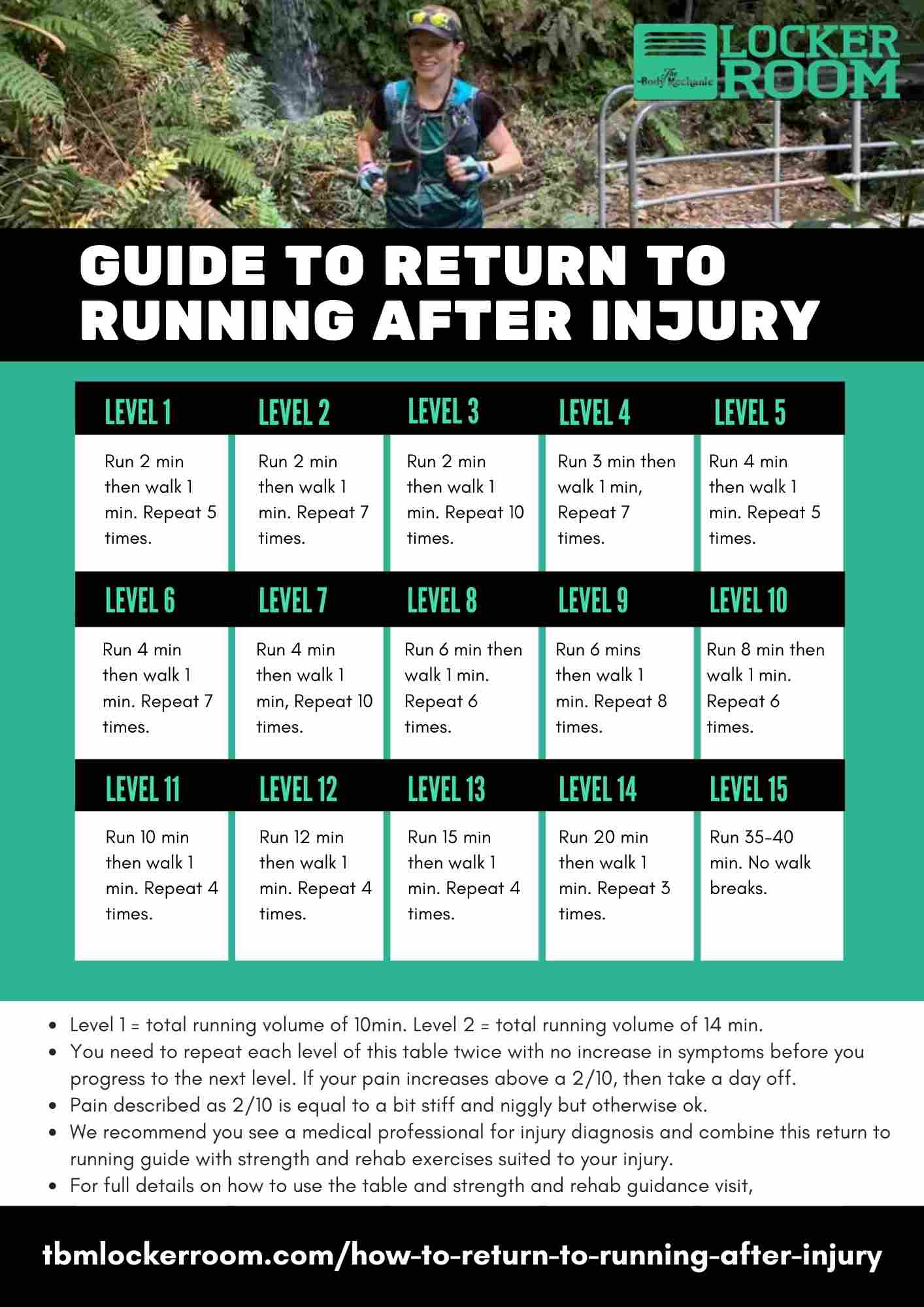If I Think Im Injured Do I Continue to Run or Rest

This guide will show you how to return to running after injury as soon as possible!
One of the most common mistakes we see runners make when they are returning to running from injury is doing too much too soon.
This is usually due to a lack of proper understanding of their injury.
What was the actual cause, and how long it had been brewing before becoming symptomatic?
The Return to Running Guide below will show you the steps you need to follow to get back to your chosen sport as soon as possible.

How not to approach your return to running
Sally is a runner who has recently experienced an ITB issue (pain around the outside of the knee). Initially, this pain came on towards the end of a 20km run.
She rested for a couple of days and then ran again but this time the pain came on after 12km.
Does this sound familiar?
Sally then decided to rest for 3 days to "really let it settle down".
Unfortunately during her next run, the pain started at 5km and became so painful that she had to stop her run early and limp home. Her knee felt like it had a "knife sticking into the side of it".
Finally, coming to terms with the fact that her knee wasn't going to improve, Sally booked in for a massage.
Plus reluctantly gave herself three full weeks of no running.
She did some swimming and some boxing classes during the break to try and maintain some fitness,
And also to prevent her from going mad!
(Here are 8 good exercises to do when you are injured)
At this point, Sally should have sought professional advice from a running specialist physiotherapist to have her injury properly diagnosed.
BUT . . . she didn't,
So this is what happened without proper advice
After three weeks of rest, Sally's knee felt quite good again with no pain at all during the day.
So, without any formal guidance, she decided to give it an "easy test" with a 5km run. The 5km run went really well, the endorphins came rushing back in, along with a sense of wellbeing.
She was on the comeback.
BUT – the next day she headed out for an 8km run (because the 5km was easy) and the knife came back to meet her after only 3km. She walks home feeling completely dejected.
In this example, we have talked about an ITB issue, but the same mechanism of injury is true of any of the common overuse running injuries. Sally could have had any of the following injuries and experienced the same problem.
- Shin splints
- Plantar fasciitis
- Achilles tendonitis
- Patella tendonitis
- Gluteal tendinopathy
- Runners Knee
If you have had anoveruse injury that was severe enough to keep you out of running for 3 weeks or more, then you have to follow a very carefully planned incremental return to running.
have to follow a very carefully planned incremental return to running.
If not, the injury will probably come back again, and the second time, just like Sally, it is usually worse!
Can't currently run?
Download the free 4 week cross-training plan for injured runners.
[Please Note: This information is most relevant for a gradual onset overuse injury (as listed above). Although it is still a good process to follow when recovering from acute injuries such as ankle sprains or muscle tears]
So how do you return to running after an injury?
After treating thousands of runners and helping them return to running after injury, we have found that you need a combined rehab approach to ensure a fast and full recovery.
You need to ensure you learn to run with good technique,
work on your strength and flexibility and,
gradually build your volume using progressive and frequent walk/run intervals.
How to use the following guide to return to running
When you are working through the guided interval table below, you need to be an honest and accurate judge of your symptoms.
You need to try and rate your pain on a 1-10 scale, where 1/10 is a very mild sensation like a tight muscle and 10/10 is an excruciating pain that you can't tolerate at all.
Back to our runner example
Let's say Sally rates her pain as 2/10 on a day-to-day basis.
It is a bit stiff and niggly in the morning and also after sitting down for a couple of hours, but is otherwise ok during normal daily activities.
When she does her first run back, it would be ok if the pain got to a 3/10 or even a 4/10 during the run, as long as it is back to her "normal" level of 2/10 by the next morning.
If it isn't back to a 2/10, then she needs another day off to allow it to settle down to a 2/10.
For more than 48 hours to settle back to a 2/10, then the run was too long and she needs to wait a few more days for the knee to settle, before trying a shorter, run.
Your Return to Running Interval Table
The following interval table can be used as a template from which to structure your return to running. Some people will be able to move through these levels faster than others. It will depend on the nature and severity of your injury.
You need to repeat each level of this table twice with no increase in symptoms before you progress to the next level.
For example, Sally might complete Level 1 on Monday and Tuesday, and her pain on Wednesday morning is still 2/10. She then does Level 2 on Wednesday, decides to take Thursday as a rest day, and does level 2 again on Friday morning.
Sally is still at a 2/10 on Saturday. So she can move on to level 3 – and so on until she is eventually running again with no walking breaks.
It may seem like your progress will be frustratingly slow using this method, but it works.
The return to running interval program has worked for the thousands of runners that we have treated over the last 20 years.
It is the most successful way of building people back into running without re-injuring themselves.

Download a PDF version you can print.
EXPLANATION OF THE LEVELS:
Level 1 – Run for 2 minutes, then walk for 1 minute, run again for 2 minutes and walk for 1 minute. Repeat a total of 5 times, so that the total running volume is 10 minutes.
Level 2 – Same as for level 1 except there are 7 reps (14 minutes of running)
NB: When following this program it is possible to run 7 days/week as long as your base level of pain is not increasing. Be sensible though, and listen to your body. If you feel like you need a day off, then take one.
Remember: You need to repeat each level of this table twice with no increase in symptoms before you progress to the next level.
Whilst this might seem slow, within a couple of weeks you may be running up to 40 minutes in one session. So stick to the plan, don't rush it and your return to running should be a smooth one.
You need to do more than just run /walk!
If you have been injured and you are ready to start building up your running again, the complete 10 Week Guide To Return To Running After Injury is ideal for you.
The 10-Week Program includes:
- Running Technique Lessons To Improve Your Running
- Run-Specific Stretches and Mobility Exercises To Loosen Tight Muscles
- Strength and Stability Exercises to Create Run-Specific Core Strength
- Foam Rolling to Relieve and Reduce Muscle Tension
- Guided week-by-week run/walk intervals all the way back to full running
- Weekly schedule of exactly when to run, and when to do body maintenance.
Start the 10 Week Return To Running Program Now
After helping thousands of clients return to running with this approach works.
Combining strength work, consistently building your running volume in a safe manner, and improving your run technique.
The program can help you return to running faster and reduce your chance of re-injury.
If you are not yet ready to start running, we recommend the free cross-training guide for injured runners.

The Free 4 Week Cross-Training Program is a great way to maintain your fitness and build strength while you can't run.
In This Guide, You Will Learn…
- Specific training options best suited to your injury
- Guidance on the right amount of cross-training
- Foam Rolling and Core Strength exercises
- How and when to reintroduce running safely
Source: https://thebodymechanic.com.au/guide-to-return-to-running-after-injury/
0 Response to "If I Think Im Injured Do I Continue to Run or Rest"
Post a Comment